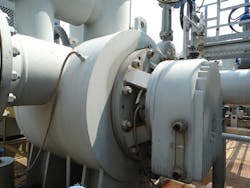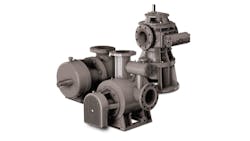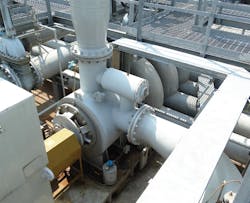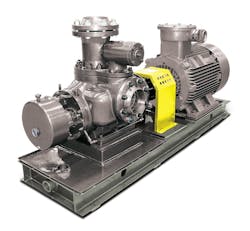Over the years, the pumping technology of choice in many fluid-transfer applications — from oil and gas and chemical production to liquid terminals that are supplied by pipelines, barges, rail cars and trucks — has been the centrifugal pump. Their method of operation — fluid enters the pump impeller along or near the rotating axis and is accelerated by the impeller, flowing radially outward into the volute discharge port — makes them well-designed for high-volume transfer applications. Centrifugal pumps also perform relatively well with water-like fluids that must be transferred through piping networks with variable flow rates.
Still, a different technology — positive displacement twin and triple screw pumps — can be a more versatile, reliable and efficient alternative than centrifugal pumps in the fluid-handling operations that are critical to many industries. This article illustrates how effective screw pumps can be as an alternative to their centrifugal cousins.
A family of highly efficient and versatile twin and triple screw pumps is designed to meet the needs of the many different fluid handling applications encountered in the oil and gas production and supply chains. All images courtesy of Blackmer
Making a move
The main challenge in making the screw pump a more prevalent option in liquid-handling applications is convincing operators to move away from a technology that is conceded to be the default one for numerous jobs. Generally speaking, the bulk of the fluids handled in industrial applications have low viscosities and must be transferred at very high flow rates, which plays to the operational strength of centrifugal pumps.
In many cases, for instance, oil and gas and chemical processing systems have been designed around the pumping technology rather than the other way around. Engineers are first familiar with centrifugal pumps and, because of this firsthand knowledge, will attempt to work within the centrifugal pump’s operational limits. They know how centrifugal pumps operate and their benefits, and they are confident the pumps are the best technology to help them meet their goals.
To illustrate this mindset, in some cases a design engineer — instead of considering a different pumping technology — will blend or heat raw crude oil to manipulate the process and get the viscosity of the fluid down to less than 300 centistokes (cSt), which makes it easier for the centrifugal pump to handle. In this instance, they are reconditioning the fluid to fit the pumping technology — irrespective of the cost impact.
In other words, when measures like this are taken to satisfy the needs of the pump, the popularity of centrifugal pumps in liquid-transfer applications becomes something of a self-fulfilling prophecy.
No matter how a liquid might be reconditioned, operators must still take care to ensure the centrifugal pump is operating on its Best Efficiency Point (BEP). The BEP is the point at which the pump works at its highest level of efficiency. Centrifugal pumps rarely operate at their BEPs.
However, when the operation of the pump moves outside the BEP window, uneven pressure will be applied to the impeller, which will cause the pump’s shaft to “deflect” because of an increase in radial thrust. When deflection occurs, higher loads are placed on the bearings and mechanical seal, which will cause damage to the pump’s casing, back plate and impeller. Ensuring operation at the BEP can be a time-intensive task since the pump must be monitored constantly and adjusted, which consumes man hours and money.
Additionally, meeting production rates and quotas has always been top priority in liquid-transfer operations, but as operating costs have continued to rise, a call for increased operational efficiency in terms of the energy required and consumed during pumping operations has been issued. In this area, centrifugal pumps can also fall short.
- Because of pump-selection complexity, oversized pumps are often chosen, leading to increased operating and maintenance costs, inefficient operation and higher-than-necessary energy consumption.
- As pump differential pressure increases, the flow rate decreases. Therefore, time-sensitive operations that are dependent on maintaining a constant flow rate will take longer, which may be costly.
- Centrifugal pump performance is adversely affected when pumping fluid with viscosity greater than 100 cSt.
These inefficiencies will lead to higher utility bills and affect the operation’s bottom line.
Advantages of screw pumps
As mentioned, the solution to the shortcomings of centrifugal pumps can be positive displacement (PD) screw pumps. The problem is not only overcoming the built-in advantages of familiarity with centrifugal pumps and the subsequent vast installed base, but it is also getting engineers to acknowledge or even become aware that alternatives like screw pumps exist.
Simply put, many engineers are not taught about screw pumps in their studies, and many who are aware of them have a preconceived notion of their shortcomings, or that they are nothing more than lube pumps capable of handing only low flow rates. In reality, today’s screw pumps have experienced advancements in terms of the flow rates that they can handle, with flow ranges from 220 gpm (833 L/min) to 11,000 gpm (41,635 L/min) now attainable.
In truth, the design of PD screw pumps makes them capable of handling various liquids — even those with higher viscosities. The operating principle involves opposed screws engaged to form a sealed cavity with the surrounding pump casing. As the drive screws turn, the fluid is shifted and steadily and constantly conveyed to the discharge port of the pump, which creates a volumetrically consistent flow rate regardless of the pumping pressure.
Screw pump technology in oil and gas fluid-handling applications offers several benefits:
- Ability to handle a wide range of flows, pressures, liquid types and viscosities
- Constant flow, even with varying system backpressures because of viscosity changes
- High volumetric and overall operating efficiencies, resulting in reduced operational costs
- Controllable output via variable capacities
- Low internal velocities
- Self-priming operation and good suction characteristics
- High tolerance for entrained air and other gases
- Low mechanical vibration that improves and lengthens service life
- Intrinsically smooth and quiet operation
- Extremely low pulsation reduces stress and prolongs the life of associated fluid-transfer components (piping, hoses, valves, etc.)
Specifically, two types of screw pump designs are most effectively used in industrial liquid-transfer applications: twin screw with timing gear (WTG) and triple screw.
WTG pumps feature external bearings and a timing-gear transmission, which produces double-suction, self-priming operation with no metal-to-metal contact between the pump’s internal components. This design helps the pump achieve the highest flow rates of any rotary PD pump, even at varying backpressures and viscosity levels. In fact, the deliverable flow rate of a PD screw pump, unlike a centrifugal pump, increases as the fluid’s viscosity increases. These design characteristics make screw pumps suitable for all types of transfer applications, including low- or high-viscosity, lubricating or nonlubricating, neutral or aggressive, and clean or contaminated fluids.
Triple screw pumps are made to handle clean lubricating fluids without solid content across a wide range of viscosities, temperatures and pressures. They are designed with a male drive spindle, two female secondary spindles and a case that contains the screws, which allows the fluid to move smoothly and continuously in an axial direction from suction to discharge. This method of operation delivers smooth, constant product flow with low noise and high levels of energy efficiency.
Conclusion
It is easy to see why industrial operators have come to rely so heavily on centrifugal pumps for their fluid-transfer needs. It is a technology that has proven over many years to fit in whole pumping systems that have been designed to optimize complicated production and supply chains. But these operators must also be open to considering alternative technologies that have been shown to create operational advantages.
Such is the case with PD screw pumps and the role they could play in optimizing fluid transfer in many industries. While screw pumps may have a higher purchase cost than centrifugal pumps, it is best to remember this old bromide: “Buying cheap just means you’ll have to buy it again.” And the main operational advantages that screw pumps have — the ability to handle a wider window of fluid viscosities at higher rates and pressures, lower energy consumption and no BEP with which to be concerned — make them poised to become a more efficient, reliable and versatile alternative to centrifugal pumps in critical liquid-handling applications.
Josh Pepper is the global product manager — screw pumps for Blackmer, located in Grand Rapids, Michigan. Blackmer is a product brand of PSG, a Dover company, located in Oakbrook Terrace, Illinois. PSG is comprised of several of the world’s leading pump brands, including Abaque, Almatec, Blackmer, Ebsray, Finder, EnviroGear, Griswold, Mouvex, Neptune, Quattroflow, RedScrew and Wilden. You can find more information about PSG at psgdover.com. Pepper can be reached at 616-248-9235 or [email protected]. For more information on Blackmer’s full line of pumps and compressors, visit blackmer.com or call 616-241-1611.









